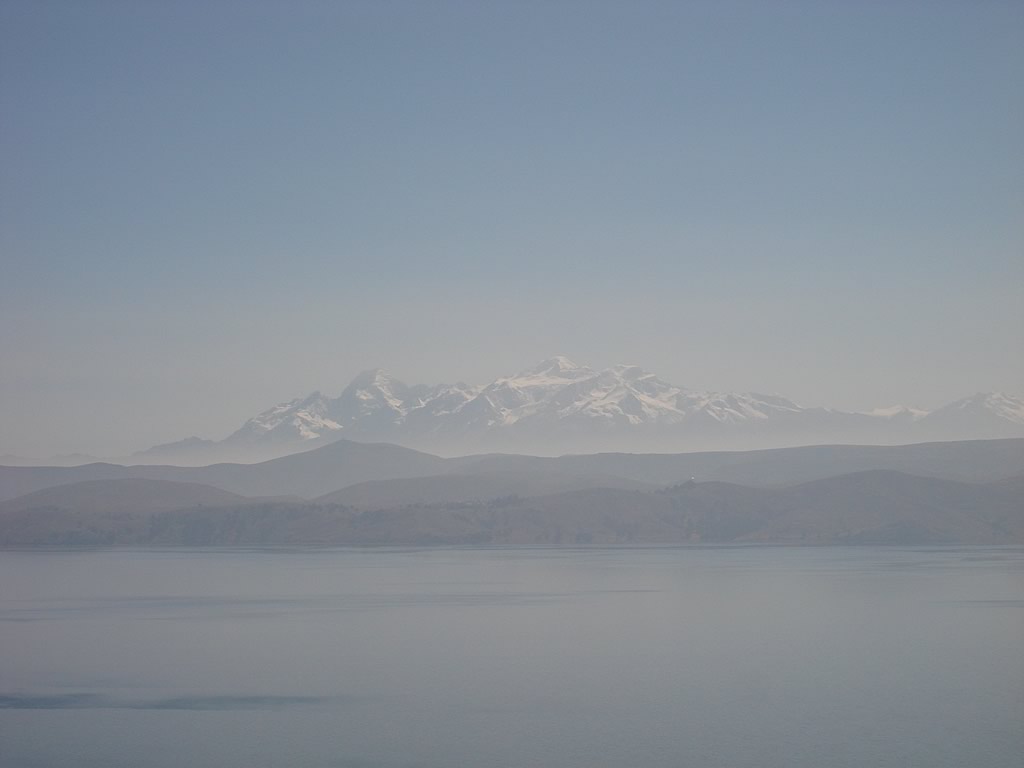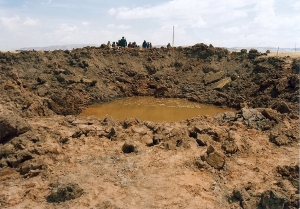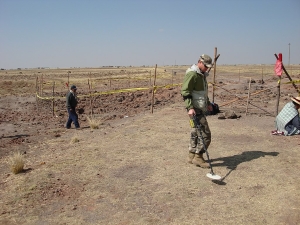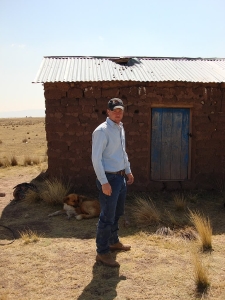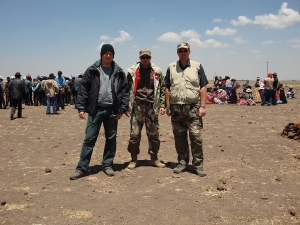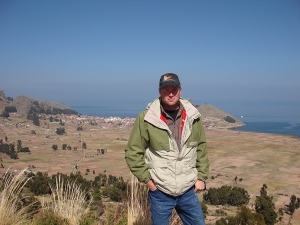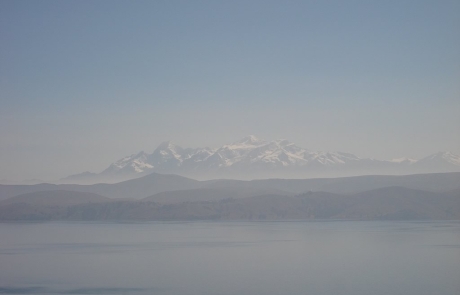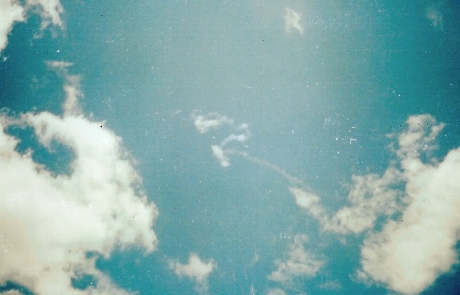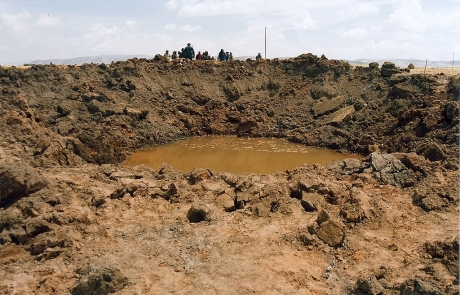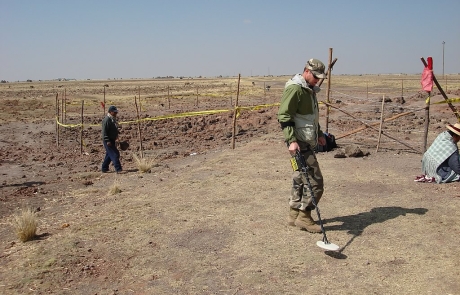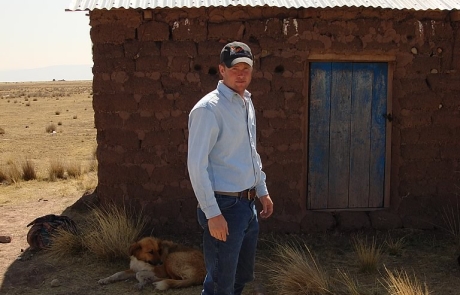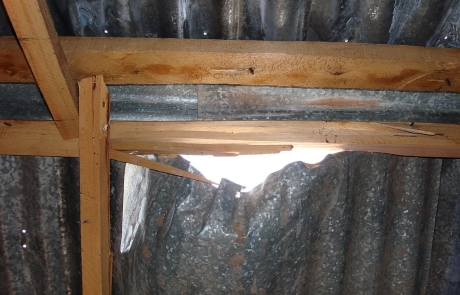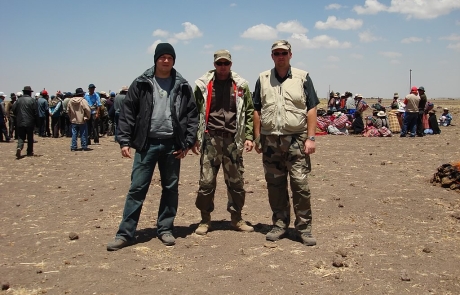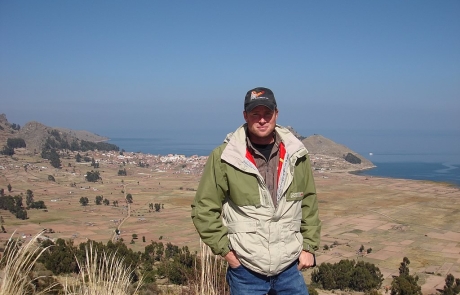Expedition Journal
Carancas Meteorite Slams into Earth
On September 15, 2007, at 11:45 am, a massive fireball appeared in the sky over Bolivia. Sonic booms were produced as the meteor descended, shattering windows along the flight path. A strong explosion was felt in Desaguadero City, along the banks of Lake Titicaca in Peru. The Uros people, living high up on the puna (plateau) in the Andes Mountains, watched in terror as this fiery object descended like a missile.
One of the local people described it as looking “like a silver jar” descending out of the clouds. The object struck the plateau with cosmic velocity, sending a plume of debris hundreds of meters into the sky. Debris from the impact site was ejected up to 200 meters away, and a nearby llama was killed by the shockwave.
After the debris and dust settled, the terrified villagers discovered a 14-meter-wide explosion crater. Newspapers stories worldwide reported the event and stated that villagers were overtaken by sickness from poisonous gases emitted from the impact site.
I first heard about the event while hunting the Puerto Lapice eucrite fall in Spain. Skeptical of the crater – and of the story of people getting sick – a few days of sifting through the facts were prerequisite before deciding to embark on an expedition to Peru.
Arrival and Escort to the Crater
On September 29, Moritz Karl, Mike Farmer, and I arrived in La Paz, Bolivia. We took a taxi to a border town near Desaguadero and crossed a small bridge into Peru – then proceeded to the local police station to inquire about the impact site. The police were very helpful and even produced pieces of meteorite from their pockets, which we purchased from them. The police called their superior, Major Anaya, and were given permission to escort us under armed guard to the crater. The police indicated to us that the indigenous people who were protecting the site could pose a threat to us and therefore put us under their protection.
The following morning we were taken to the site in armored police vehicles. The crater had been fenced off by the local tribe, but after talking to village elders we were allowed entry into the crater. We examined and photographed the crater. The meteorite had impacted above an underground spring, and the crater had filled with water up to one third of its depth.
We purchased many pieces from the locals, and after assembling my metal detector, I found several fragments in the 2 to 5 gram range – as well as two iron nodules and two metal veins embedded in large chunks of red clay that had been ejected from the crater.
Upon discovery of the first Irona Jewel, I learned a valuable lesson about Peruvian culture. I had yelled out to Mike, informing him of my discovery, and he soon arrived at the find location concurrent with two Peruvian women. One old woman indicated that she wanted to see the meteorite, so I handed it to her. A clownish look immediately appeared on her face as she stuck her arm up her bloused skirt and hid my meteorite…somewhere. Needless to say, I didn’t go looking for it, and our local guide was not able to retrieve it either. It had quickly become apparent that if you are foolish enough to hand one of the villagers something, they would assume you didn’t need it very badly.
Mike spent considerable time speaking with the mayor of the village. The mayor informed us that there would be a council meeting later that day and invited Mike to speak about the importance of preserving the presumed, large meteorite fragments buried deep in the crater. We were escorted to the tribal meeting where village elders spoke their mind, and Mike explained our position in Spanish and advised the village elders – who then translated his ideas to the people as to the best course of action to preserve the meteoritic materials. Mike had explained that the water in the crater was damaging the material and that they needed to pump the water out and excavate the floor of the crater. The meeting was concluded with a ceremony and an offering to the mountain spirit ‘Apu,’ which consisted of a roll of scrolls with a dried llama fetus in the center, burnt in a llama dung fire.
The next day a workforce of local villagers assembled at the crater with a water pump and hand shovels. After many hours of discussion, the pump was finally set up, and slowly the water level in the crater began to drop. With 80% of the water pumped out of the crater, the mayor called an end to the workday.
Things Go Sideways in Peru
Feeling very discouraged, we returned to town – where we were promptly intercepted by local police and taken to the nearby police headquarters. The police took our passports and inquired as to where we were staying. They questioned us for several hours and then escorted us back to our hotel. The three of us had a discussion and decided that we should leave the country immediately. We walked down to the border crossing, a little more than a block away from our hotel. Seeing that it was closed upon arrival, we turned around and were met by Major Anaya and two other police officers in plainclothes. They inquired as to our intentions, and after making some indirect threats and extorting hundreds of dollars out of us, we were instructed to meet them at our hotel. Later that night, I heard the policemen banging on Mike’s door. After a lot of alarming noise, I was startled by sudden pounding on my door. I walked apprehensively over to open the door, expecting to be taken into custody. After opening the door, I saw Mike standing there, sweating and visibly shaken. He told me that the police had returned, demanding more money, and that he had refused to pay them. They told Mike that federal police from Lima were coming the next day to take us back to the capital city for “questioning.”
Mike calmly crossed the road and struck up a casual conversation with a taxi driver. After slipping the driver several hundred dollars, he returned to Moritz and me, instructing us to cross the road and quickly put our bags in the taxi. Seconds later the taxi driver peeled out, hopping the car up onto the sidewalk to get around several vegetable carts. As the car accelerated, I looked back to see a police officer hurdling over a cart full of chickens. He made it to within several meters of our bumper before his legs gave out on him.
After several kilometers, we were stopped by two policemen and a man in a business suit standing in the middle of the road. I lowered my head, knowing that handcuffs would soon follow. But after a great deal of yelling, the taxi driver proceeded to drive away. Moritz and I frantically asked Mike what the yelling was all about, and Mike snapped back at us to be quiet as he conversed with the taxi driver. The man in a business suit was just a politician demanding a ride to Lima, and the taxi driver had basically told him to piss off because he already had a fare!
Safety in Bolivia
We drove 30 kilometers to a small town and paid our way to cross Lake Titicaca on a barge into Bolivia. Later that day, we arrived in the Bolivian capital of La Paz. After checking into a hotel, we discovered a message from Lee Belland, Vice Consul to the US Embassy in Lima Peru, upon checking email. The letter said that the morning’s newspaper reported that we had been arrested, and instructed us to contact him immediately if we required assistance.
Our brush with extortion and possible incarceration during the Peruvian expedition was hair-raising, to say the least. It serves as a good example of the kind of threats that face international meteorite hunters in our quest for these cosmic visitors.
IT WAS CLASSIFIED AS AN H4-5, S3 ORDINARY CHONDRITE
Meteorite Details
| Name: | Carancas |
| Location: | Carancas, Chucuito, Puno, Peru |
| Classification: | H4-5 |
| Witnessed: | Yes |
| Fell: | September 15, 2007 |
| TKW: | ~1600 kg |


